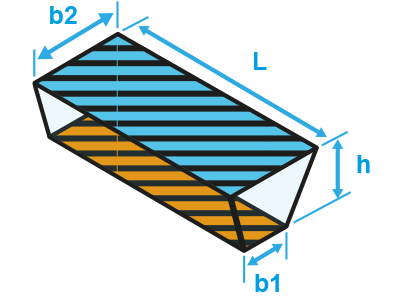Breach flow formula (Water Overlay)
Flow through breaches is calculated based on the weir formula, including the consideration between free flow and submerged flow situations. The weir formula is supplied with the breach width (as stand-in for the weir width), which is always calculated with the breach growth formula before calculating the weir flow. The downstream water level can optionally be measured with an additionally configured Breach Level Area, or an automatically placed at a distance based on the configured measurement distance and the orientation of the breach.
For the entry area, the area where the water originates from, the following also applies:
- The water level used is defined by either an input area or the external water level.
- In case of an external area, the surface height used is defined by external surface level. This height limits how far the water level can be lowered.
- Optionally a second value can be supplied for the external surface level. In that case, the second value represents the area of the bottom.
- In case of an input area, the average water level is based on the water level on the individual grid cells of the input area.
Each timestep, the external water level is changed based on the amount of water flowing in or out.
In case :
Where:
- = Datum height of the bottom of the area water flows from.
- = The water level of the entry area at time ; In case of an external area: EXTERNAL_WATER_LEVEL of the breach.
- = The calculated water flow which takes place at time , based on the weir formula.
- = The timestep in seconds.
- = The limited volume of water transported, based on the remaining water.
- = The size of in the entry area; In case of an external area: EXTERNAL_AREA of the breach.
- = The (optional) size of the bottom of the entry area; In case of an external area: the second value provided for the EXTERNAL_AREA of the breach. In case only one value is provided,
Trapezoidal prism
The external water area can also be represented as a trapezoidal prism. The new water level then has to be calculated differently.
The length and width of the surface area are currently considered equal. Therefore:
The width of the bottom area is then calculated as:
Next, we will calculate the new water level based on :
if , determine the new water level based on a box shape:
otherwise, determine the new water level based on the determinant and flow direction:
Where:
- = Length of the trapezoidal prism
- = The size of in the entry area; In case of an external area: EXTERNAL_AREA of the breach.
- = Width of the original top (surface at ) of the trapezoid
- = The (optional) size of the bottom of the entry area; In case of an external area: the second value provided for the EXTERNAL_AREA of the breach. In case only one value is provided, : = Datum height of the bottom of the area water flows from.
- = Width of the bottom of the trapezoid
- = The water level of the entry area at time ; In case of an external area: EXTERNAL_WATER_LEVEL of the breach.
- Datum height of the bottom of the area water flows from.
- = The initial relative water height in the external area.
- = Slope of the trapezoid
- = Area of the trapezoidal slide of the trapezoid prism at time
- = Constant based on new area of the trapezoid
- = Polynomial discriminant
- = The limited volume of water transported, based on the remaining water.
Notes
- The water level we cannot become lower than the surface height se, defined by EXTERNAL_SURFACE_LEVEL in case of an external entry area. In case of an input area within the project, the surface height is determined per grid cell.
- When water is flowing from the project area to an external area, the slope of the external area remains the same, even when the water level rises above the original water level. In the case of a trapezoidal prism, is extrapolated upwards.
Related
The following topics are related to this formula.
- Features
- Breach
- Formulas
- Weir formula
- Breach growth formula
- Models
- Surface model











































